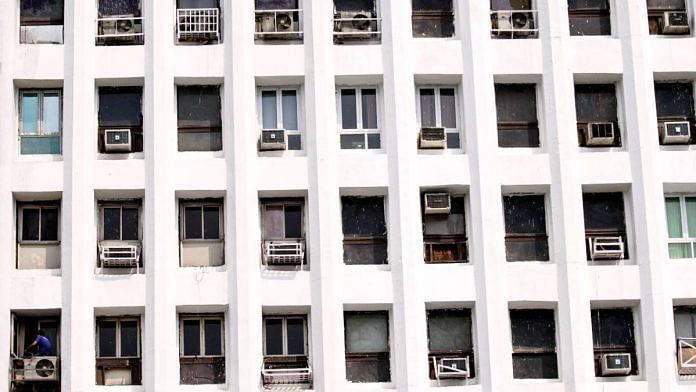New Delhi: Fire departments in Delhi-NCR are on alert for a new threat — air-conditioner blasts. The intense heat this summer season, which calls for round-the-clock air conditioning, is leading to a rise in such fires across the city and National Capital Region.
Data shared by the fire departments of Delhi’s satellite towns shows that between 1 April and 5 June, 32 fires were reported in Ghaziabad and 85 in Noida that were triggered by short circuits and AC blasts. In Delhi, 12 such cases were reported in this period.
Over the last two days, at least two indoor ACs caught fire in residential societies in Uttar Pradesh’s Noida and Ghaziabad.
The combination of high temperature and humidity is driving up the demand for air conditioning. However, the continuous operation of ACs is overloading the power supply of residential areas, significantly increasing the risk of such fires.
Atul Garg, Director of the Delhi Fire Services, told ThePrint that this season, the fire helpline had received a record number of over 200 calls daily reporting a fire, adding that this was the first time in the last decade that the department had recorded such a surge in calls this time of the year.
In fact, officials said the helpline usually sees an increase in calls only during Diwali.
“When temperatures rise, the risk of fires increases. Short circuits and AC blasts are also the biggest cause of fires this season,” the fire services chief said.
The Delhi fire department has been conducting regular interactions and awareness drives with resident welfare associations of societies to discuss the dos and don’ts in case of an AC fire.
Startling rise in fire cases
On Thursday, an AC unit went up in flames at a two-storey residential building in Ghaziabad’s Vaishali. On 3 June, a similar case was reported from a commercial complex in Noida. No injuries or deaths occurred in either case.
“Most of the cases that we have received over the last few days have been minor fires, which were controlled within a few hours. But in the past, there have been instances where such fires can aggravate quickly and become dangerous,” an official from the Ghaziabad fire unit told ThePrint.
Data of the last few years shows a surge in residential fires across India.
According to data from the National Crime Records Bureau released in December 2023, 7,566 fires were reported across the country in 2022, in which 7,435 people died. More than half of these fatalities were caused by residential fires. NCRB data for 2021 shows that 8,491 fire accidents were reported across the country, in which 8,348 people died.
Increasing heat and power demand
This year, northwest and central India experienced one of the worst heat spells which broke 80-year records. Maximum temperatures in many parts reached nearly 50 degrees Celsius, and high night-time temperatures increased discomfort for residents.
In the last week of May, many observatories in Delhi and NCR recorded daytime temperatures above 49 degrees Celsius for two to three days at a stretch.
In May, peak power demand in Delhi broke previous records twice, according to data from BSES. First, on 28 May power demand surged to 7,717 MW, breaking the previous record of 7,695 MW demand recorded on 29 June, 2022. On the same day, the demand crossed the 8,000 MW mark.
Experts say this spells out a dangerous trend for the future.
Vishwas Chitale, senior programme lead at the Council on Energy, Environment and Water, told ThePrint that recent studies suggest that Indian cities are warming at almost twice the rate of the rest of the country due to the compounding factors of climate change and urbanisation.
“The severe heatwave conditions observed in cities like Delhi testify to this. The impacts we are witnessing are multifaceted, which include water scarcity and record-breaking power demand,” he said.
“To adapt to these conditions, it is imperative that our heat action plans shift from a response-centric to a preparedness-centric approach, mapping granular-level heat risks to help administrators prioritise health interventions. These plans should also focus on long-term heat risk mitigation strategies, such as heat-resilient infrastructure, increasing green cover, and installing sufficient outdoor cooling shelters,” he added.
How to avoid AC blast
According to fire officials, AC blasts are preventable. All that people need to do is regularly maintain their AC units and switch them off in between so that they don’t overheat the motors.
A senior official from the Delhi Fire Services said that before the start of the season, owners must ensure that ACs are serviced and have enough gas to function efficiently. They also need to check if the sanctioned power load of their residential complex or apartment unit adheres to the ACs installed.
“Because it is so hot outside, we all tend to just switch on the ACs at the lowest temperature settings. This creates a huge load on the appliance. It is preferable to switch on an AC at a higher temperature, which will also provide effective cooling,” the official said.
He also explained that old AC units need to be replaced at regular intervals to prevent such fires. “It is a machine at the end of the day. If you maintain it well, it will function safely.”
(Edited by Nida Fatima Siddiqui)
Also Read: Lapsed licence, no fire exit & oxygen refilling — why Delhi hospital fire was disaster-in-waiting






